10 most bizarre fish in the world's oceans
Categories: Animals
By Pictolic https://pictolic.com/article/10-most-bizarre-fish-in-the-world39s-oceans.htmlJune 11, 1910 was born Jacques Yves Cousteau - the most famous explorer of the ocean and the inventor of aqualung. In honor of the oceanographer's birthday, we present to you a selection of the most unusual inhabitants of the world's oceans, discovered not without the help of his invention
(Total 10 photos)
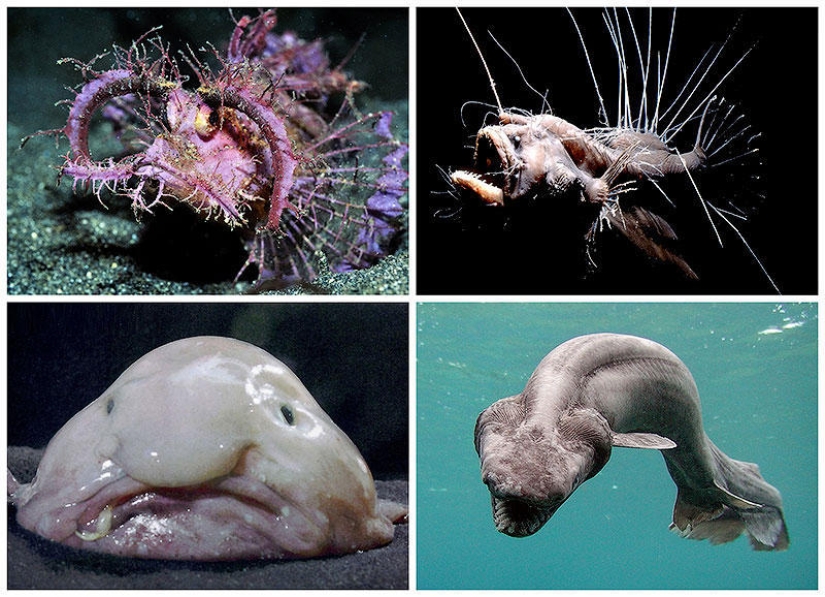
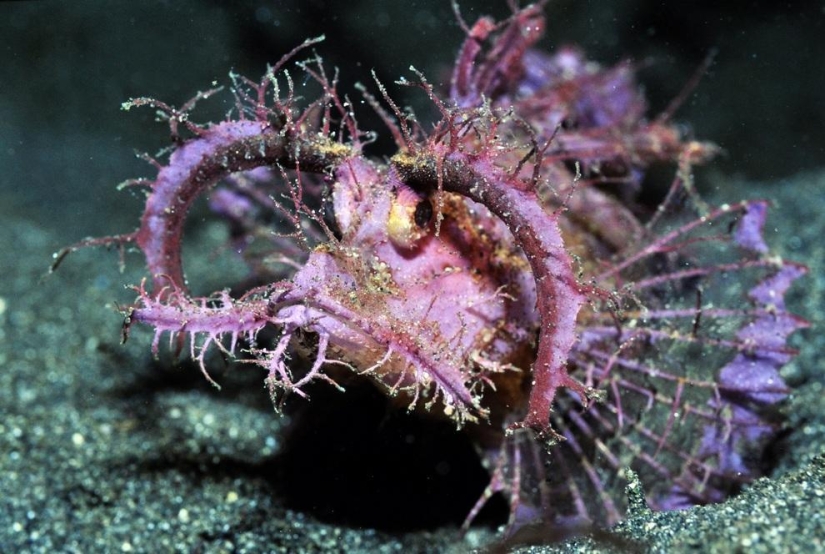
1. Ambon Scorpionfish, lat. Pteroidichthys amboinensis.
Opened in 1856. Easily recognizable by the huge "eyebrows" - specific growths above the eyes. Able to change color and shed. Conducts "guerrilla" hunting - disguised at the bottom and waiting for the victim. Not uncommon and quite well studied, but her extravagant appearance is simply not to be missed! (Roger Steene/Conservation International)
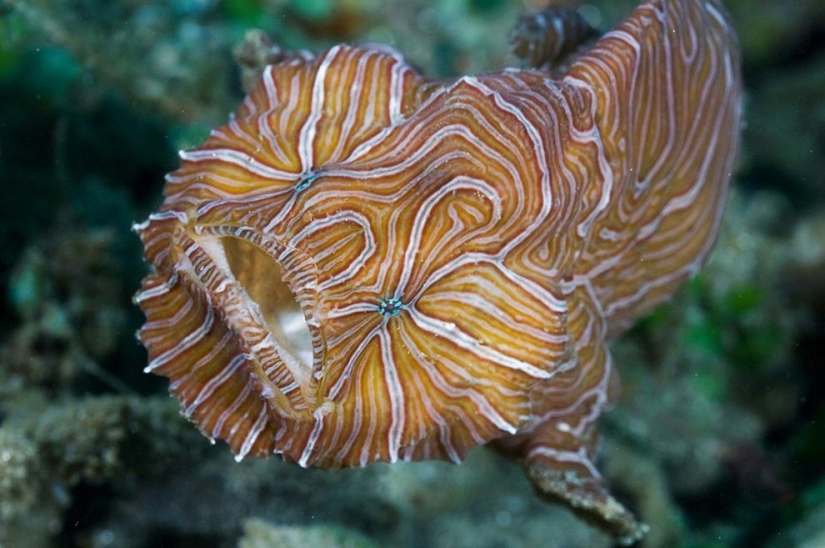
2. Psychedelic frogfish (eng. Psychedelic Frogfish, lat. Histiophryne psychedelica).
Opened in 2009. A very unusual fish - the caudal fin is curved to the side, the pectoral fins are modified and look like the paws of land animals. The head is large, wide-spaced eyes are directed forward, like in vertebrates, due to which the fish has a kind of "facial expression". The color of the fish is yellow or reddish with sinuous white-blue stripes radiating in different directions from the blue eyes. Unlike other fish that swim, this species moves as if by jumping, pushing off the bottom with its pectoral fins and pushing water out of the gill slits, creating jet thrust. The tail of the fish is bent to the side and cannot directly direct the movement of the body, therefore it oscillates from side to side. Also, the fish can crawl along the bottom with the help of pectoral fins, turning them over like legs. (David Hall/EOL Rapid Response Team)

3. Rag-picker (eng. Leafy Seadragon, lat. Phycodurus eques).
Opened in 1865. Representatives of this species of fish are notable for the fact that their entire body and head are covered with processes that mimic the thallus of algae. Although these processes look like fins, they do not take part in swimming, they serve for camouflage (both when hunting shrimp and for protection from enemies). It lives in the waters of the Indian Ocean, washing southern, southeastern and southwestern Australia, as well as northern and eastern Tasmania. Feeds on plankton, small shrimps, algae. Having no teeth, the rag-picker swallows food whole. (lecate/Flickr)
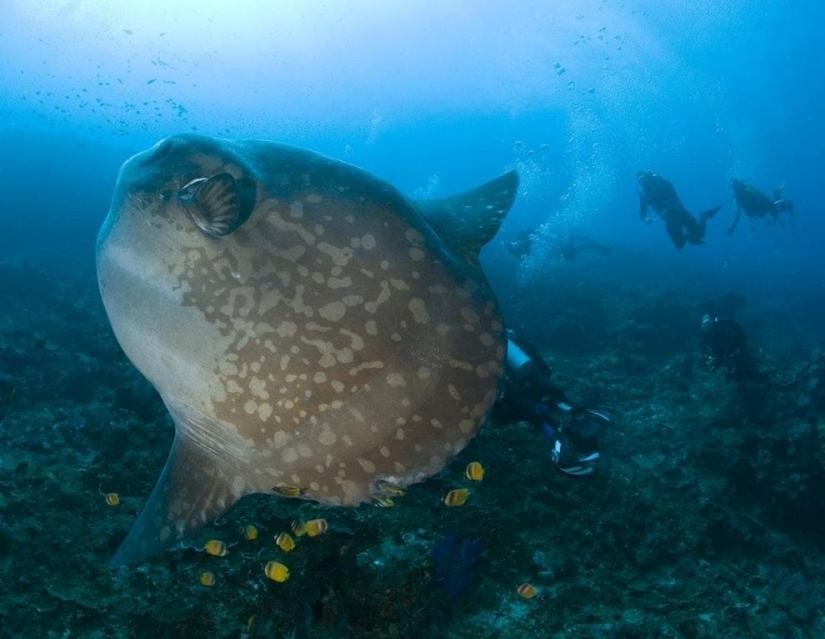
4. Moon-fish (eng. Ocean Sunfish, lat. Mola mola).
Opened in 1758. The laterally compressed body is extremely high and short, which gives the fish an extremely strange appearance: it resembles a disk in shape. The tail is very short, wide and truncated; dorsal, caudal and anal fins are interconnected. The skin of the moon fish is thick and elastic, covered with small bony tubercles. You can often see the moon-fish lying on its side on the surface of the water. An adult moon fish is a very poor swimmer, unable to overcome a strong current. It feeds on plankton, as well as squid, eel larvae, salps, ctenophores and jellyfish. It can reach gigantic sizes of several tens of meters and weigh 1.5 tons. (Franco Banfi)
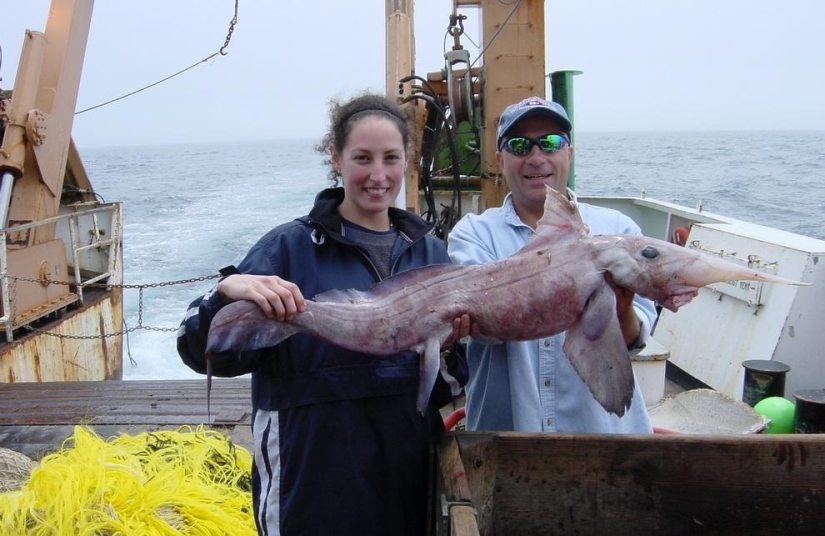
5. Broad-nosed chimera (English Broadnose chimaera, lat. Rhinochimaera atlantica).
Opened in 1909. Utterly disgusting-looking jelly-like fish. It lives on the deep bottom of the Atlantic Ocean and feeds on mollusks. Very poorly studied. (Jay Burnett, NOAA/NMFS/NEFSC)
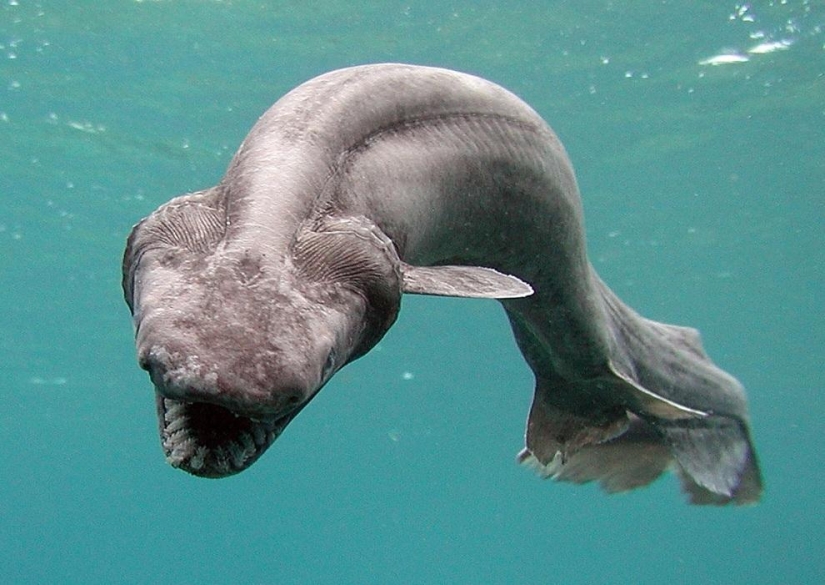
6. Frilled Shark, lat. Chlamydoselachus anguineus.
Opened in 1884. These sharks look much more like a strange sea snake or eel than their closest relatives. In the frilled shark, the gill openings, of which there are six on each side, are covered with skin folds. In this case, the membranes of the first gill slit cross the throat of the fish and are connected to each other, forming a wide skin lobe. Along with the goblin shark, it is one of the rarest sharks on the planet. No more than a hundred specimens of these fish are known. They are very poorly studied. (Awashima Marine Park/Getty Images)
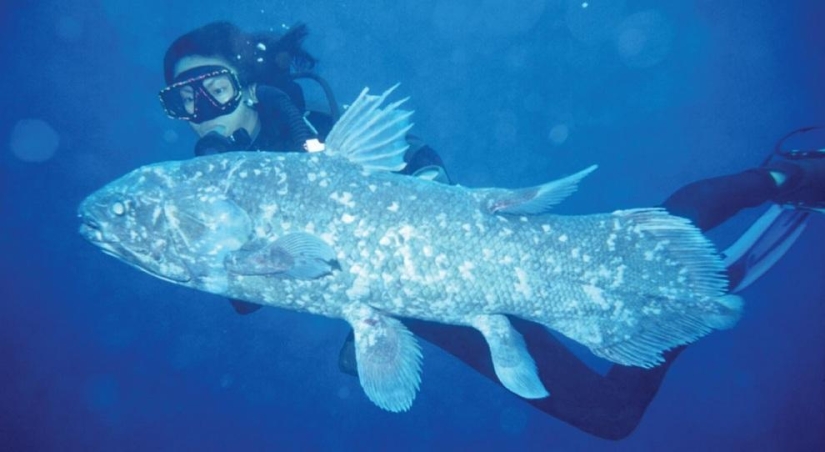
7. Indonesian coelacanth (English Indonesian Coelacanth, lat. Latimeria menadoensis).
Opened in 1999. Living fossil and probably the oldest fish on Earth. Before the discovery of the first representative of the order of coelicans, which includes coelacanth, he was considered completely extinct. The time of divergence of two modern species of coelacanths is 30–40 Ma. No more than a dozen were caught alive. (Pearson-Benjamin Cummings)
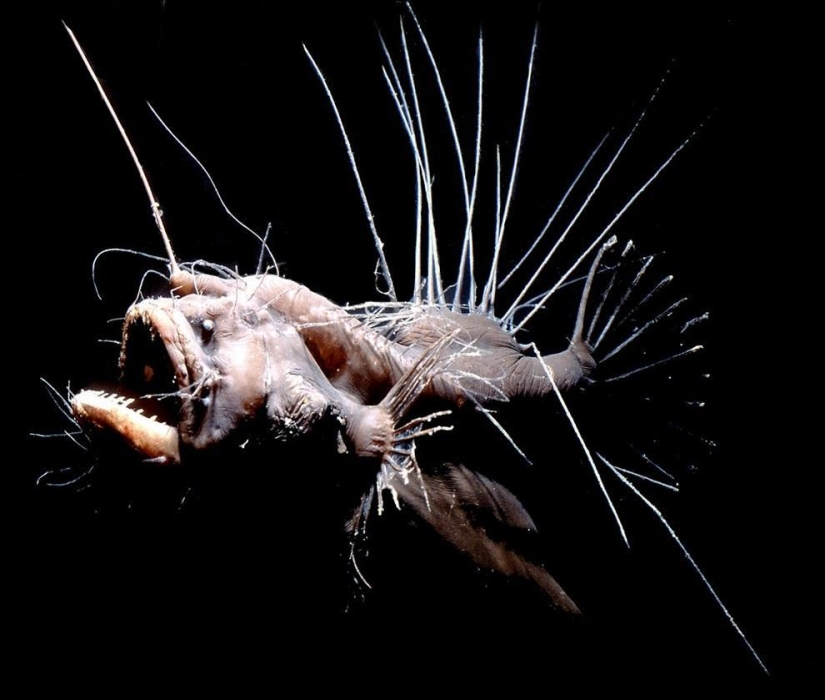
8. Hairy monkfish (Eng. Hairy Angler, lat. Caulophryne polynema).
Opened in 1930. Very strange and scary fish that live in the deep bottom, where there is no sunlight - from 1 km and deeper. To lure the inhabitants of the deep sea, it uses a special luminous outgrowth on the forehead, characteristic of the entire detachment of anglerfish. Thanks to a special metabolism and extremely sharp teeth, he can eat anything that comes across, even if the victim is many times larger and is also a predator. It reproduces no less strangely than it looks and eats - due to the unusually harsh conditions and the rarity of fish, the male (ten times smaller than the female) attaches itself to the flesh of his chosen one and transfers everything he needs through the blood. (BBC)
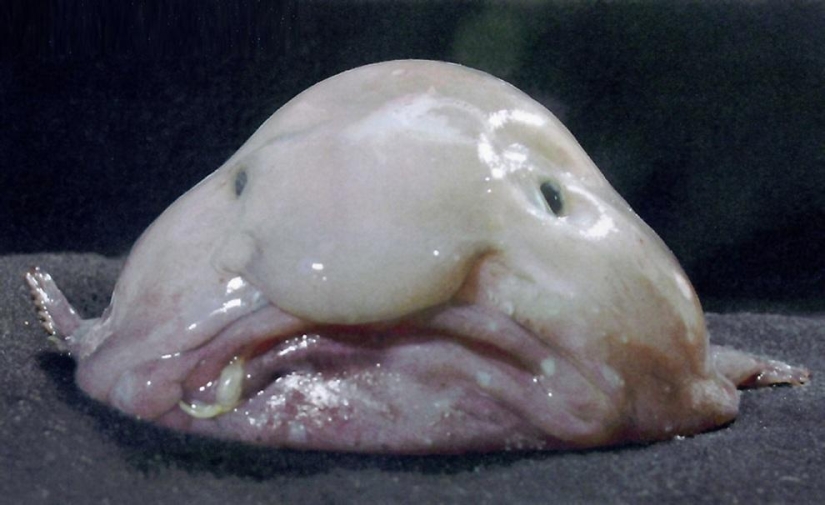
9. Drop fish (eng. Blobfish, lat. Psychrolutes marcidus).
Opened in 1926. Often mistaken for a joke. In fact, this is a very real species of deep-sea bottom marine fish of the Psycholute family, which on the surface take on a “jelly” appearance with a “sad expression”. It is poorly studied, but this is enough to recognize it as one of the most bizarre. Pictured is a copy of the Australian Museum. (Kerryn Parkinson/Australian Museum)
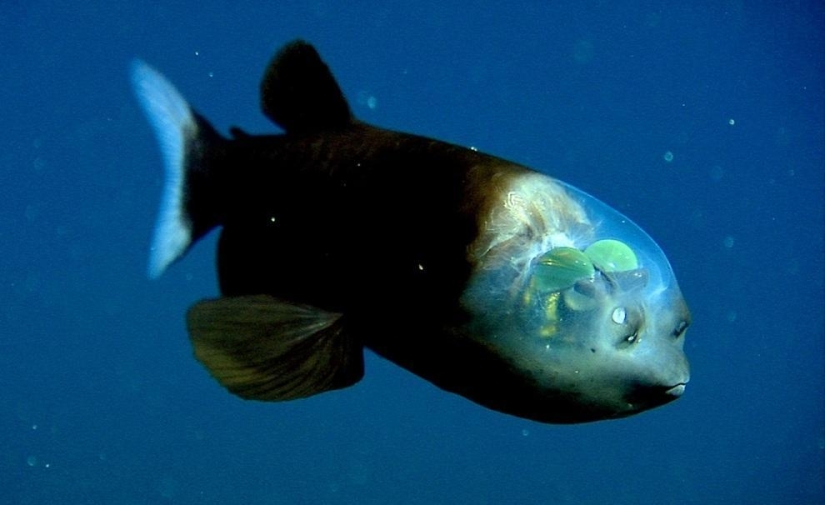
10. Smallmouth macropinna (eng., lat. Macropinna microstoma) - winner for quirkiness.
Opened in 1939. It lives at a very great depth, therefore it is poorly studied. In particular, the principle of fish vision was not entirely clear. It was supposed that she must experience very great difficulties in view of the fact that she sees only upwards. Only in 2009 was the structure of the eye of this fish fully studied. Apparently, when trying to study it earlier, the fish simply could not stand the change in pressure. The most notable feature of this species is the transparent dome-shaped shell that covers its head from above and to the sides, and the large, usually upward-pointing, cylindrical eyes that are found under this shell. A dense and elastic overlying sheath is attached to the dorsal scales at the back, and on the sides to the wide and transparent periocular bones, which provide protection for the organs of vision. This overlying structure is usually lost (or at least severely damaged) when fish are brought to the surface in trawls and nets, so its existence was not known until recently. Under the covering shell is a chamber filled with a transparent liquid, in which, in fact, the eyes of the fish are located; the eyes of living fish are painted bright green and are separated by a thin bony septum, which, extending backwards, expands and accommodates the brain. Anterior to each eye, but behind the mouth, is a large, rounded pocket that contains an olfactory receptor rosette. That is, what at first glance in photographs of live fish seems to be eyes, is actually an olfactory organ. The green color is caused by the presence of a specific yellow pigment in them. It is believed that this pigment provides a special filtering of light coming from above and reduces its brightness, which allows the fish to distinguish the bioluminescence of potential prey. (Monterey Bay Aquarium Research Institute)
Keywords: Ten | Ocean | Fish | Top
Post News ArticleRecent articles

Twitter user @FactBuffet collects interesting facts about everything. Today we bring to your attention another series of facts that ...

Aomori Prefecture in the north of the Japanese island of Honshu is an agricultural region famous for its delicious apples. In ...
Related articles

Red caviar has long been one of the traditional foods that adorn the Christmas table. Agree that it would be a shame to open the ...

Human intervention in the affairs of nature is extremely rarely successful. Especially a lot of trouble was brought to the ...

Palmateer felicity (Felicity Palmateer) began to photograph stunning mini-movie, which conquers the waves in Hawaii, Fiji and ...

Imagine a baby vampire or a tiny zombie with glass eyes ... An artist from the USA Bean Shanine specializes in creating such ...